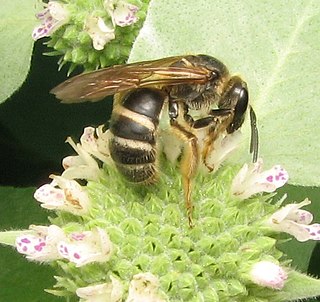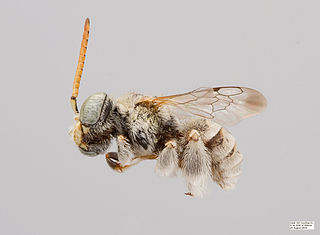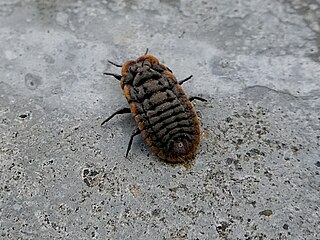
Carpenter bees are species in the genus Xylocopa of the subfamily Xylocopinae. The genus includes some 500 bees in 31 subgenera. The common name "carpenter bee" derives from their nesting behavior; nearly all species burrow into hard plant material such as dead wood or bamboo. The main exceptions are species in the subgenus Proxylocopa, which dig nesting tunnels in suitable soil.

Mealybugs are insects in the family Pseudococcidae, unarmored scale insects found in moist, warm habitats. Of the more than 2000 described species, many are considered pests as they feed on plant juices of greenhouse plants, house plants and subtropical trees and also act as a vector for several plant diseases. Some ants live in symbiotic relationships with them, protecting them from predators and feeding off the honeydew which they excrete.

Charles Robert Cockerell was an English architect, archaeologist, and writer. He studied architecture under Robert Smirke. He went on an extended Grand Tour lasting seven years, mainly spent in Greece. He was involved in major archaeological discoveries while in Greece. On returning to London, he set up a successful architectural practice. Appointed Professor of Architecture at the Royal Academy of Arts, he served in that position between 1839 and 1859. He wrote many articles and books on both archaeology and architecture. In 1848, he became the first recipient of the Royal Gold Medal.

Hylaeus is a large and diverse cosmopolitan genus within the bee family Colletidae. This genus is also known as the yellow-faced bees or masked bees. This genus is the only truly globally distributed colletid, occurring on all continents except Antarctica.

The Aulacidae are a small, cosmopolitan family of wasps, with two extant genera containing some 200 known species. They are primarily endoparasitoids of wood wasps (Xiphydriidae) and xylophagous beetles. They are closely related to the family Gasteruptiidae, sharing the feature of having the first and second metasomal tergites fused, and having the head on a long pronotal "neck", though they are not nearly as slender and elongate as gasteruptiids, nor are their hind legs club-like, and they have more sculptured thoraces. They share the evanioid trait of having the metasoma attached very high above the hind coxae on the propodeum.

Australian native bees are a group of bees that play a crucial role in the pollination of native plants. There are over 1,700 species of native bees in Australia, ranging from small solitary bees to the social stingless bees. Native bees are important for native ecosystems, providing pollination services to native plants, and hold value for Australian agriculture.

Theodore Dru Alison Cockerell (1866–1948) was an entomologist and systematic biologist who published nearly 4,000 papers, some of them only a few lines long. Cockerell's speciality was the insect order Hymenoptera, an area of study where he described specimens from the United States, the West Indies, Honduras, the Philippines, Africa, and Asia. Cockerell named at least 5,500 species and varieties of bees and almost 150 genera and subgenera, representing over a quarter of all species of bees known during his lifetime. In addition to his extensive studies of bees, he published papers on scale insects, slugs, moths, fish scales, fungi, roses and other flowers, mollusks, and a wide variety of other plants and animals.

Captain Stanley Cockerell AFC was a British World War I flying ace credited with seven aerial victories. He later became a test pilot for Vickers and attempted the first flight from Cairo to Cape Town.

Euhesma is a genus within the bee family Colletidae found in Australia. There are over 90 species described. The group lacks strong unifying features and maybe further split in the future. The type species is Euhesma wahlenbergiae.
Aleurodicus is a genus of whiteflies in the family Aleyrodidae.
Anthidium severini is a species of bee in the family Megachilidae, the leaf-cutter, carder, or mason bees.

Hydriomena? protrita is an extinct species of moth in the family Geometridae, and possibly in the modern genus Hydriomena. The species is known from late Eocene, Priabonian stage, lake deposits of the Florissant Formation in Teller County, Colorado, United States. It was first described by Theodore Dru Alison Cockerell in 1922.
Apatetrinae is a subfamily of moths in the family Gelechiidae. The subfamily was described by Edward Meyrick in 1947.

Epeolus is a genus of cuckoo bees in the family Apidae. They are often known as variegated cuckoo-bees.

Sphecodes is a genus of cuckoo bees from the family Halictidae, the majority of which are black and red in colour and are colloquially known as blood bees. Sphecodes bees are kleptoparasitic on other bees, especially bees in the genera Lasioglossum, Halictus and Andrena. The adults consume nectar, but because they use other bees' provisions to feed their offspring they do not collect pollen.

Halictini is a tribe of sweat bees in the sub-family Halictinae.

Anthophorula is a genus of bees in the family Apidae. There are more than 60 described species in Anthophorula.

Drosicha is a genus of true bugs belonging to the family Monophlebidae. The species of this genus are found in Eurasia.














